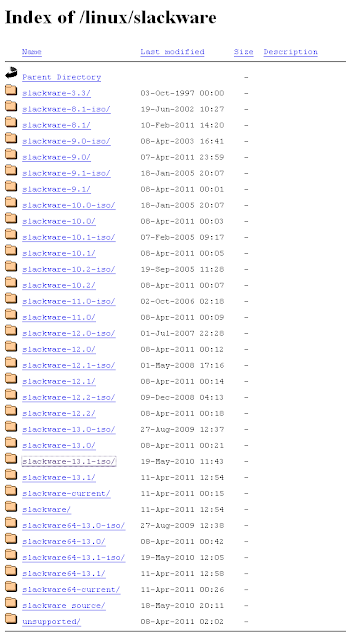I've already created a user account. I'm kind of stubborn (and yes, we've established masochistic) so I'm doing all this from the user account. From the root account, you can drop the 'su -c' and the quotes from these commands.
13.37 has been out for a while, so first step is to update the beast. For that, I need Internet access. I'm just going with an wired connection for now. No challenge here; plug in the cord, turn on the computer.
On to choosing the server for updates. If you're not familiar with the text editor vi, replace 'vi' with 'pico' in these commands.
It wants one and only one server, so I deleted only one '#' from the front of the server I want. I could jump into updating now, but there's a snag. If I let it go as is, it'll be set to update the kernel on its own.
Why's that bad? I don't know. It's bad. Supposedly. Google it. Probably because Slack is masochist-friendly. The proper way is apparently to compile it yourself. Or you can be a ninny and re-install Slack like I do.
I've nuked all the '#' signs before the kernel entries. On to the updates.
su -c "slackpkg install-new"
su -c "slackpkg upgrade-all"
On occasion, I am tortured with the nightmare of installing Windows XP. Well, it's the newest edition I have, and I'm not about to go purchase Vista or newer. Don't look at me like that; I'm human too. I have to protect myself from zombies. And I'm not fighting with Wine to do it.
But have you met the process of installing Windows updates on XP in 2012? They alone take well over an hour. It requires babysitting because a bunch of them can't be installed at the same time. Confirm install, wait, reboot. Confirm install, wait, reboot. Confirm install...
Windows XP updates make me want to chew my toes off. And then there's anti-malware and a decent firewall and a web browser that doesn't suck and a word processing program and...
Make the nightmares stop!
Oh. Ahem. Back to Slack:
Since it's a new install, I'm telling it to overwrite the configuration files. Done!
Elapsed time interacting: 2 minutes
Elapsed time waiting: 15 minutes
Total time interacting: 3 minutes
Total time waiting: 15 minutes



